CASE LAW
PART I
BOARDS OF APPEAL ACTIVITIES IN 2009
1. Introduction
For statistics on the appeal procedure in 2009, see the tables in Section 2 below, together with the further information given in Section 3. General developments in Directorate-General 3, and the information products available, are described in Sections 4 to 6. For the boards' case law in 2009 see Part II below. A number of important decisions from the first half of 2010 have also been taken into consideration.
2. Statistics
|
|
|
|
| New cases | Settled | Pending |
| |||||||
|---|---|---|---|---|---|---|---|---|---|---|---|---|---|---|---|
|
|
|
|
|
2009 |
2008 |
2009 |
2008 |
31.12.2009 |
|
|||||
|
|
|
|
|
|
|
|
|
|
|
|
|
|
|
|
Enlarged Board of Appeal |
|
|
22 |
|
15 |
|
16 |
|
4 |
|
20 |
|
|
||
|
|
|
|
1 |
|
4 |
|
0 |
|
1 |
|
7 |
|
|
|
|
|
|
21 |
|
11 |
|
16 |
|
3 |
|
13 |
|
|
||
|
|
|
|
|
|
|
|
|
|
|
|
|
|
|
|
Legal Board of Appeal |
|
20 |
|
18 |
|
21 |
|
13 |
|
17 |
|
|
|||
|
|
|
|
|
|
|
|
|
|
|
|
|
|
|
|
Technical boards of Appeal |
|
2.484 |
100,0% |
2.403 |
100,0% |
1.918 |
100,0% |
1.782 |
100,0% |
5.387 |
100,0% |
|
|||
|
|
|
|
|
|
|
|
|
|
|
|
|
|
|
|
- Examination procedure |
|
|
1226 |
49,3% |
1110 |
46,2% |
777 |
40,5% |
738 |
41,4% |
2609 |
48,4% |
|
||
(ex-parte) |
|
|
|
|
|
|
|
|
|
|
|
|
|
|
|
- Opposition procedure |
|
|
1249 |
50,3% |
1252 |
52,1% |
1116 |
58,2% |
999 |
56,1% |
2775 |
51,5% |
|
||
(inter-partes) |
|
|
|
|
|
|
|
|
|
|
|
|
|
||
- Total protests |
|
|
9 |
0,4% |
41 |
1,7% |
25 |
1,3% |
45 |
2,5% |
3 |
0,1% |
|
||
|
|
|
|
|
|
|
|
|
|
|
|
|
|
|
|
Mechanics |
|
|
|
731 |
29,4% |
763 |
31,8% |
675 |
35,2% |
621 |
34,9% |
1413 |
26,2% |
|
|
|
|
|
188 |
|
184 |
|
148 |
|
172 |
|
312 |
|
|
||
|
|
|
542 |
|
565 |
|
521 |
|
435 |
|
1101 |
|
|
||
|
|
|
1 |
|
14 |
|
6 |
|
14 |
|
0 |
|
|
||
|
|
|
|
|
|
|
|
|
|
|
|
|
|
|
|
Chemistry |
|
|
|
826 |
33,3% |
766 |
31,9% |
688 |
35,9% |
669 |
37,5% |
1824 |
33,9% |
|
|
|
|
|
295 |
|
225 |
|
215 |
|
216 |
|
548 |
|
|
||
|
|
|
525 |
|
523 |
|
456 |
|
433 |
|
1.274 |
|
|
||
|
|
|
6 |
|
18 |
|
17 |
|
20 |
|
2 |
|
|
||
|
|
|
|
|
|
|
|
|
|
|
|
|
|
|
|
Physics |
|
|
|
349 |
14,0% |
304 |
12,6% |
195 |
10,2% |
203 |
11,4% |
750 |
13,9% |
|
|
|
|
|
255 |
|
220 |
|
142 |
|
131 |
|
555 |
|
|
||
|
|
|
93 |
|
81 |
|
51 |
|
70 |
|
195 |
|
|
||
|
|
|
1 |
|
3 |
|
2 |
|
2 |
|
0 |
|
|
||
|
|
|
|
|
|
|
|
|
|
|
|
|
|
|
|
Electricity |
|
|
578 |
23,3% |
570 |
23,7% |
360 |
18,7% |
289 |
16,2% |
1400 |
26,0% |
|
||
|
|
|
488 |
|
481 |
|
272 |
|
219 |
|
1194 |
|
|
||
|
|
|
89 |
|
83 |
|
88 |
|
61 |
|
205 |
|
|
||
|
|
|
1 |
|
6 |
|
0 |
|
9 |
|
1 |
|
|
||
|
|
|
|
|
|
|
|
|
|
|
|
|
|
|
|
Disciplinary Board of Appeal |
|
|
17 |
|
28 |
|
24 |
|
50 |
|
17 |
|
|
||
|
|
|
|
|
|
|
|
|
|
|
|
|
|
|
|
|
|
TOTAL |
|
2.543 |
|
2.464 |
|
1.979 |
|
1.849 |
|
5.441 |
|
|
|
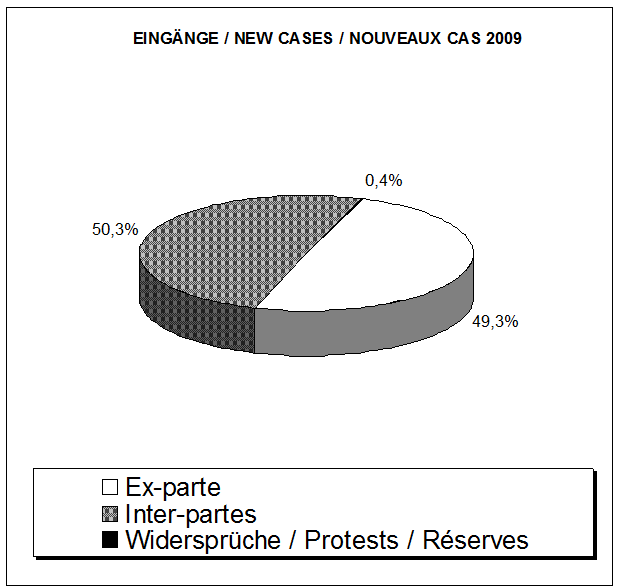
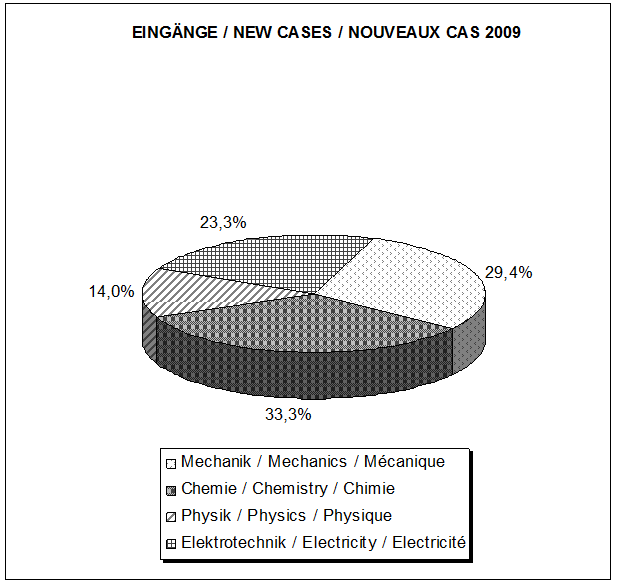
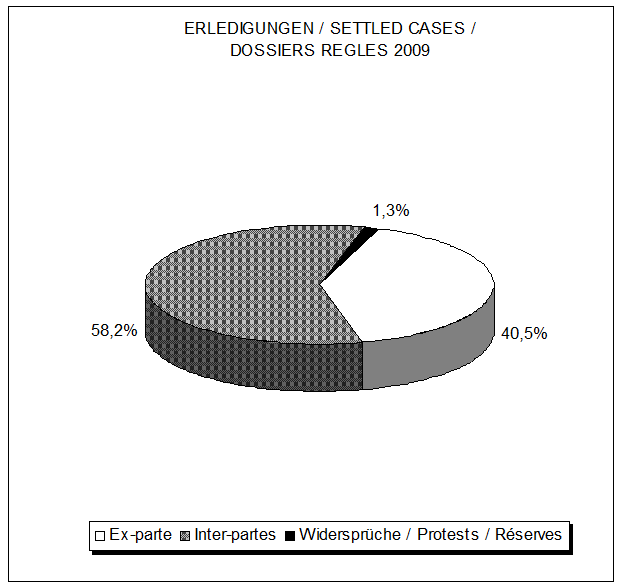
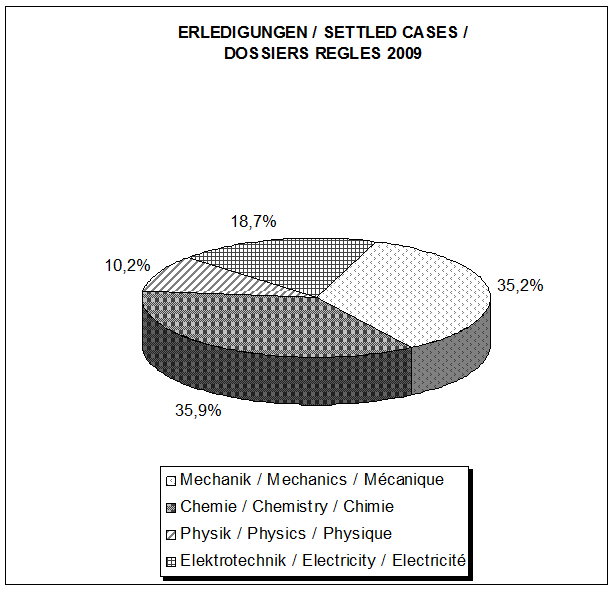
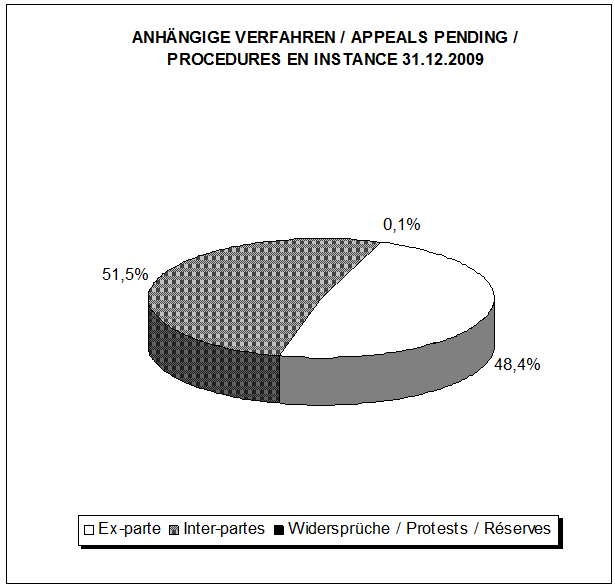
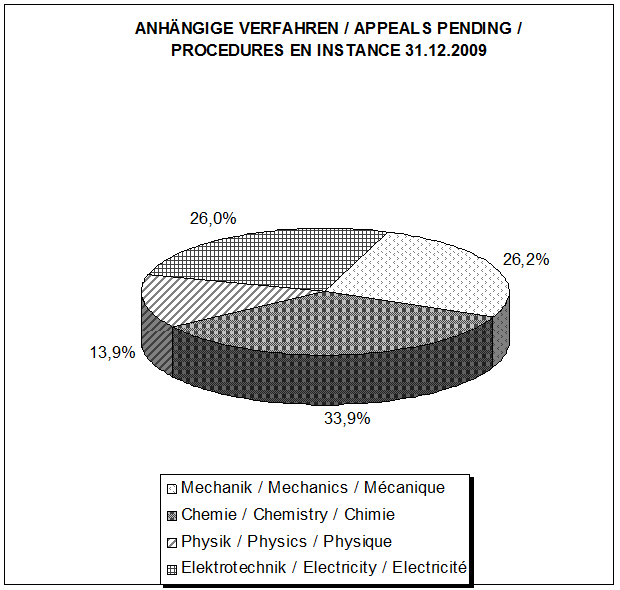
3. More about the boards' activities
3.1 Proceedings before the Enlarged Board of Appeal
3.1.1 Referrals to the Enlarged Board of Appeal under Article 112 EPC
In 2009 there was one new referral to the Enlarged Board of Appeal (2008: 4) and two interlocutory decisions were issued (2008: 1). In 2010, there have so far been two additional referrals to the Enlarged Board of Appeal and four other proceedings have been brought to a conclusion.
The two interlocutory decisions G 2/08 and G 3/08 concerned requests for the exclusion of members of the Enlarged Board of Appeal on the ground of partiality. Both requests were rejected.
In G 1/07 the Enlarged Board decided that the claimed imaging method, in which, when carried out, maintaining the life and health of the subject is important and which comprises or encompasses an invasive step representing a substantial physical intervention on the body which requires professional medical expertise to be carried out and which entails a substantial health risk even when carried out with the required professional care and expertise, is excluded from patentability as a method for treatment of the human or animal body by surgery pursuant to Article 53(c) EPC.
In G 2/08 the Enlarged Board held that Article 54(5) EPC does not exclude a medicament which is already used in the treatment of an illness from being patented for use in a different treatment by therapy of the same illness. Article 54(5) EPC now permits purpose-related product protection for any further specific use of a known medicament in a method of therapy. The Enlarged Board also decided that, where the subject-matter of a claim is rendered novel only by a new therapeutic use of a medicament, such claim may no longer have the format of a so-called Swiss-type claim. A time limit of three months after publication of the decision in the Official Journal of the EPO was set in order for future applications to comply with this new situation.
In G 3/08 the President referred a number of questions concerning the exclusion from patentability of computer programs as such (Article 52(2)(c) and (3) EPC). The Enlarged Board of Appeal considered the referral inadmissible and stated inter alia that, whilst there was a difference between two decisions of the boards of appeal concerning whether a claim to a program on a computer-readable medium necessarily avoided exclusion from patentability under Art. 52(2) EPC, this was a legitimate development of the case law and not a divergence which would make the referral admissible.
In G 4/08 the Enlarged Board of Appeal ruled inter alia that if an international patent application has been filed and published under the PCT in an EPO official language it is not possible, on entry into the European phase, to file a translation of the application into one of the two others which would then become the language of the proceedings.
At the date of publication, five referrals were pending before the Enlarged Board of Appeal.
G 2/07 relates to a non-microbiological process for the production of plants which contains the steps of crossing and selecting plants, and the question is whether such a process escapes the exclusion of Article 53(b) EPC 1973 merely because it contains, as a further step or as part of any of the steps of crossing and selection, an additional feature of a technical nature. This referral has been consolidated with G 1/08, which deals with the same issue.
G 1/09 is concerned with the question whether an application refused by the examining division remains pending until expiry of the time limit for filing an appeal where no appeal has been filed.
G 1/10 is concerned with the procedural issue of whether the patent proprietor's request for correction of the grant decision under Rule 140 EPC which was filed after the initiation of opposition proceedings is an admissible remedy on which only the examining division has the power to take a binding decision.
In G 2/10 the following question was referred to the Enlarged Board of Appeal: "Does a disclaimer infringe Article 123(2) EPC if its subject-matter was disclosed as an embodiment of the invention in the application as filed?"
3.1.2 Petition for review under Article 112a EPC
Following the changes made under EPC 2000, Article 112a EPC allows parties adversely affected by a decision of the boards of appeal to file a petition for review by the Enlarged Board on the grounds that a fundamental procedural defect occurred in the appeal proceedings or that a criminal act may have had an impact on the decision. By the end of 2009, 21 petitions had been brought to a conclusion; three have since been withdrawn. In R 7/09 the Enlarged Board of Appeal set aside the decision and ordered that the proceedings before the board of appeal be re-opened. It judged that a fundamental violation of Article 113 EPC had occurred in that the statement setting out the grounds of appeal was considered not to have been communicated to the petitioner who thus had no opportunity to comment on the grounds for the decision under review.
At the time of writing, there were 13 petitions for review pending before the Enlarged Board of Appeal.
3.2 Outcome of proceedings before the technical boards of appeal
59% of ex parte cases were settled after substantive legal review, i.e. not terminated through rejection as inadmissible, withdrawal of the appeal or application, or the like. The outcome of these 459 cases was as follows:
- appeal successful in whole or in part: 222 cases (48.4%)
- - grant of patent ordered: 114 cases (24.9%)
- - resumption of examination proceedings ordered: 108 cases (23.5%)
- appeal dismissed: 237 cases (51.6%).
Ex-parte cases settled after substantive legal review
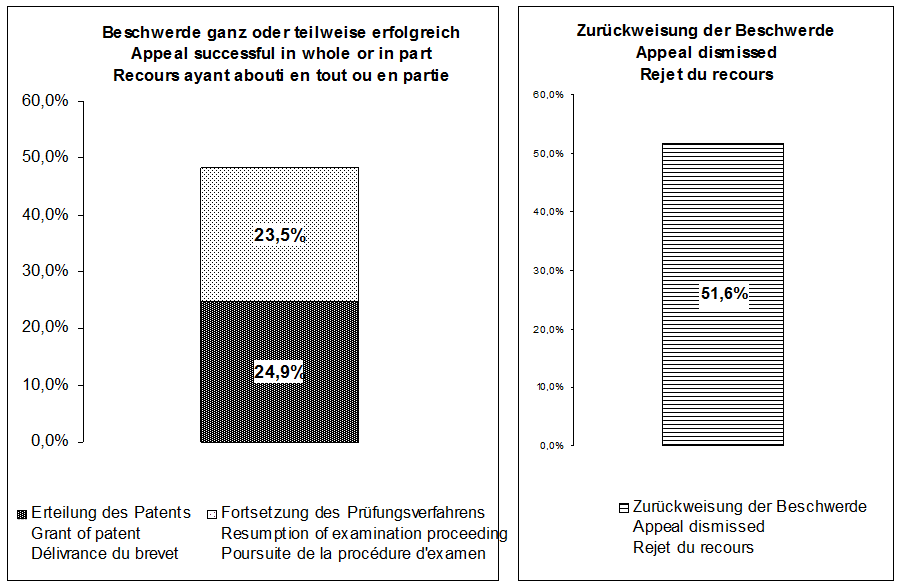
Of inter partes cases, 76% were settled after substantive legal review. The outcome of these 845 cases was as follows (no distinction is drawn between appeals by patentees and appeals by opponents):
- appeal successful in whole or in part: 508 cases (60.1%), ending in
- - maintenance of patent as granted: 17 cases (2%),
- - maintenance of patent in amended form: 189 cases (22.4%)
- - revocation of patent: 214 cases (25.3%) and
- - resumption of opposition proceedings: 88 cases (10.4%).
- appeal dismissed: 337 cases (39.9%).
Inter partes cases settled after substantive legal review
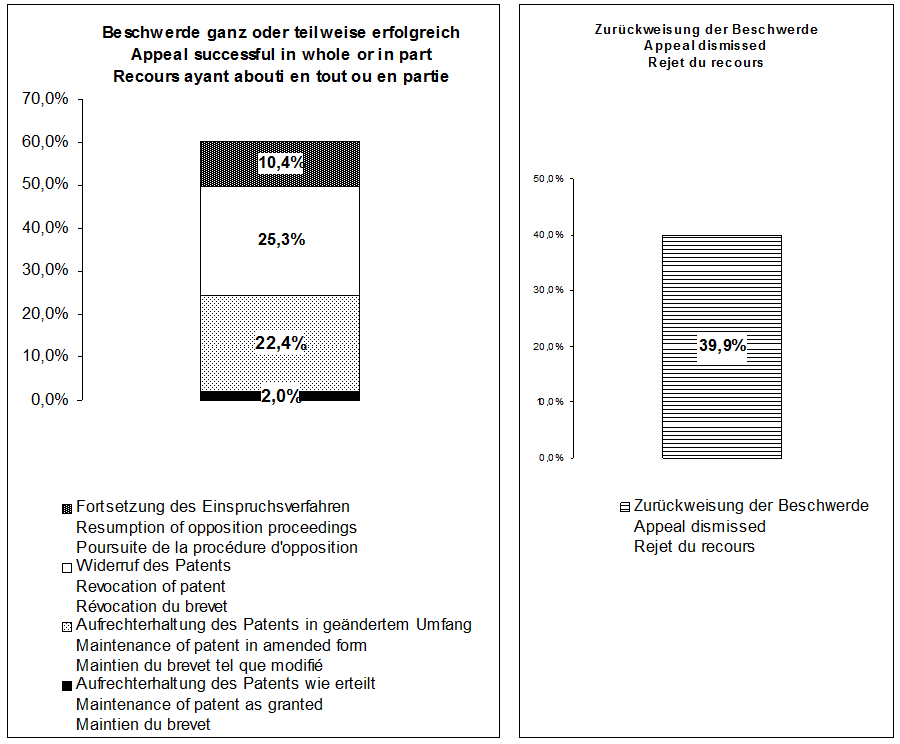
3.3 Proceedings before the Disciplinary Board of Appeal
3.3.1 New cases 2009
- re European qualifying examination: 17 cases
- re professional representatives' code of conduct: 0 cases
3.3.2 Cases settled 2009
- re European qualifying examination: 24 cases
- re professional representatives' code of conduct: 0 cases
3.3.3 Cases pending 2009
- re European qualifying examination: 17 cases
- re professional representatives' code of conduct: 0 cases
3.4 Length of proceedings
The average length of technical proceedings was 25 months (ex parte: 23 months; inter partes: 26 months).
The number of cases pending for over two years at the end of the year under review (31.12.2009) – i.e. filed in 2007 or earlier – is as follows: 2000: 1; 2001: 0; 2002: 2; 2003: 2; 2004: 9; 2005: 40; 2006: 221; 2007: 975 (in total: 1 250).
3.5 Breakdown of appeals and oral proceedings by language
The language used in appeal proceedings and protests filed in 2009 was as follows: English 71.1%, German 23.0% and French 5.9%.
A total of 1 234 oral proceedings took place in 2009, with the following language breakdown: English 67.5%, German 25.3% and French 7.2%.
4. Contacts with national courts, applicants and representatives
The annual MSBA meeting between members of the boards of appeal and SACEPO representatives was held on 17 June 2009, the day before the SACEPO annual meeting.
The boards of appeal received a number of high-level visitors from contracting and non-contracting states. Representatives of DG 3 also participated as speakers in various seminars and conferences.
5. Number of staff and distribution of responsibilities
On 31 December 2009, there were 156 board of appeal chairmen and members (2008: 150). The 101 technically qualified and 28 legally qualified members were divided amongst 26 technical and one legal board.
The composition of each board is published in the EPO Official Journal (Supplement to OJ EPO 1; Rule 12(4) EPC). Amendments to the business distribution scheme are published on the EPO's website.
The total number of DG 3 staff was 221 on 31 December 2009 (215 on 31 December 2008).
6. Information on recent board of appeal case law
DG 3's efforts to develop information tools for providing information on board of appeal case law to the public are continuing. All the decisions handed down since 1980 are available free of charge on the EPO's website (www.epo.org). They can be accessed via the reference number or via search terms. They are also available on the ESPACE® LEGAL DVD, which is published twice a year.
With respect to the other DG 3 information products, the sixth edition of the Case Law of the Boards of Appeal of the European Patent Office, a comprehensive survey of all the case law of the boards of appeal in the three languages, was published in July 2010. "Information from DG 3 Appeals", a collection comprising the boards' rules of procedure and other texts of importance for appeal proceedings, was published as a supplement to OJ EPO 1/2010.
The Legal Research Service publications "Case Law of the Boards of Appeal of the EPO", "European National Patent Decisions Report" (first edition) and the equivalent electronic versions on the ESPACE® LEGAL DVD are available from the EPO sub-office in Vienna.